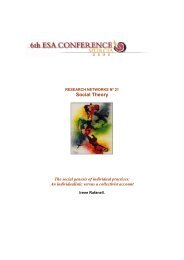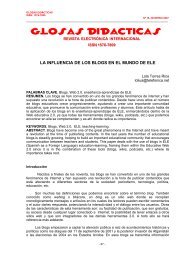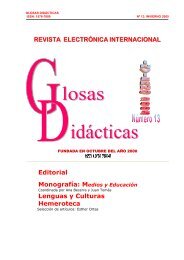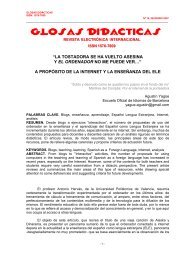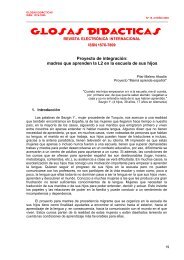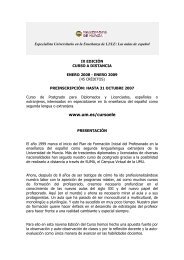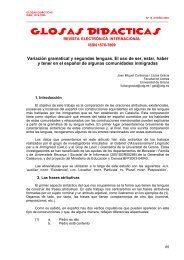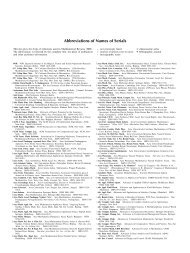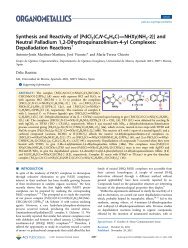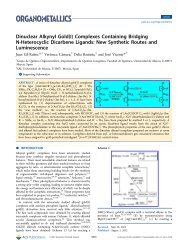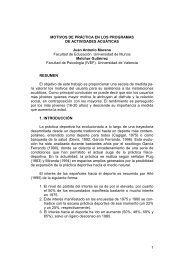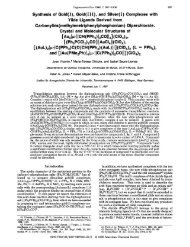New Acetonyl Palladium(II) Complexes - Universidad de Murcia
New Acetonyl Palladium(II) Complexes - Universidad de Murcia
New Acetonyl Palladium(II) Complexes - Universidad de Murcia
Create successful ePaper yourself
Turn your PDF publications into a flip-book with our unique Google optimized e-Paper software.
<strong>New</strong> <strong>Acetonyl</strong> <strong>Palladium</strong>(<strong>II</strong>) <strong>Complexes</strong> Organometallics, Vol. 27, No. 15, 2008 3981<br />
Scheme 1<br />
ad<strong>de</strong>d norbornene (120 mg, 1.27 mmol) un<strong>de</strong>r N 2 . The resulting<br />
suspension was stirred for 1 h and then filtered through Celite. To<br />
the filtrate was ad<strong>de</strong>d dbbpy (170 mg, 0.635 mmol) to give a<br />
suspension, which was concentrated (3 mL) and then filtered off,<br />
washed with n-pentane (5 mL), and air-dried, to give 12 as a yellow<br />
solid. The filtrate was concentrated, Et 2 O was ad<strong>de</strong>d, and the<br />
suspension was filtered to give a second crop of 12. Yield: 170<br />
mg, 47%. IR (cm -1 ): ν(CdO) 1714; ν(Pd-Cl) 326. 1 H NMR (300<br />
MHz, CDCl 3 ): δ 9.21 (m, 1H, dbbpy), 8.69 (m, 1H, dbbpy), 7.96<br />
(m, 1H, dbbpy), 7.90 (m, dbbpy), 7.59 (m, 1H, dbbpy), 7.48 (m,<br />
1H, dbbpy), 3.45 (dd, 1H, CH 2 C(O), 2 J HH ) 17.6, 3 J HH ) 6.3 Hz),<br />
2.89 (dd, 1H, CH 2 C(O), 2 J HH ) 17.6, 3 J HH ) 8.4 Hz), 2.50-2.47<br />
(m, 2H, H7 and H12), 2.24-2.18 (m, 2H, H8 and H13), 2.10 (s,<br />
3H, Me), 1.87 (m, 1H, H9), 1.60-1.53 (m, 1H, H10′), 1.44 (s, 9H,<br />
t Bu), 1.40 (s, 9H, t Bu), 1.35-1.25 (m, 2H, H10 and H11), 1.15<br />
(m, 1H, H13′), 1.11 (m, 1H, H11′). 13 C{ 1 H} NMR (75.45 MHz,<br />
CDCl 3 ): δ 210.4 (CO), 162.8 (C, dbbpy), 156.3 (C, dbbpy), 152.8<br />
(C, dbbpy), 149.1 (C, dbbpy), 148.7 (C, dbbpy), 123.7 (C, dbbpy),<br />
123.4 (C, dbbpy), 118.6 (C, dbbpy), 117.4 (C, dbbpy), 51.1 (CH 2 ),<br />
50.5 (C7), 46.3 (C12), 46.2 (C8), 42.7 (C9), 36.2 (C13), 35.4<br />
(CMe 3 ), 35.3 (CMe 3 ), 31.6 (Me), 31.3 (C11), 30.4 (CMe 3 ), 30.2<br />
(CMe 3 ), 29.7 (C10). Anal. Calcd for C 28 H 39 ClN 2 OPd: C, 59.89; H,<br />
7.00; N, 4.99. Found: C, 58.66; H, 7.61; N, 5.01. See discussion.<br />
Synthesis of [Pd{CH 2 C(O)Me}Cl(cod)] (13). To a suspension<br />
of 1 (150 mg, 0.75 mmol) in dry THF (15 mL) was ad<strong>de</strong>d cod<br />
(104 µL, 0.85 mmol) un<strong>de</strong>r N 2 . When the solid was disolved, the<br />
reaction mixture was filtered un<strong>de</strong>r N 2 and the filtrate was<br />
concentrated (ca. 3 mL). Addition of n-pentane (20 mL) gave a<br />
suspension that was stirred in an acetone/ice bath for 20 min and<br />
filtered un<strong>de</strong>r N 2 . The solid was washed with n-hexane (2 × 5 mL)<br />
and air-dried to give 13 as a yellow solid. Yield: 188 mg, 81%.<br />
Dec pt: 100 °C. IR (cm -1 ): ν(CdO) 1648. 1 H NMR (200 MHz,<br />
C 6 D 6 ): δ 5.71 (2H, CH, cod), 5.10 (2H, CH, cod), 3.00 (2H,<br />
CH 2 CO), 2.53 (3H, Me), 1.40-1.81 (8H, CH 2 , cod). 13 C{ 1 H} NMR<br />
(50.32 MHz, C 6 D 6 ): δ 208.9 (CO), 123.3 (CH, cod), 107.0 (CH,<br />
cod), 35.8 (CH 2 CO), 31.3 (MeCO), 30.8 (CH 2 , cod), 27.4 (CH 2 ,<br />
cod). Anal. Calcd for C 11 H 17 ClOPd: C, 43.02; H, 5.58. Found: C,<br />
43.0; H, 5.52. Single crystals of 13 were obtained by slow diffusion<br />
of Et 2 O into a solution of 13 in CDCl 3 .<br />
Synthesis of [Pd 2 {η 3 -CH 2 C[CH 2 C(O)Me]CMe 2 } 2 (µ-Cl) 2 ] (14).<br />
A solution of 1 (106 mg, 0.54 mmol) in dry MeCN (5 mL) was<br />
stirred with 3-methyl-1,2-butadiene (63.8 µL, 0.64 mmol) un<strong>de</strong>r<br />
N 2 for 1 h and then filtered through Celite and concentrated to<br />
dryness. The residue was stirred with n-pentane (10 mL) and the<br />
resulting suspension was filtered. The solid was washed with<br />
n-pentane (5 mL) and air-dried to give 14 as a pale yellow solid.<br />
Yield: 110 mg, 77%. Dec pt: 180 °C. IR (cm -1 ): ν(CdO) 1714;<br />
ν(Pd-Cl) 260, 240. 1 H NMR (200 MHz, CDCl 3 ): δ 3.78 (H A ,AB<br />
system, 1H, CH 2 C(O), 2 J HH ) 17.4 Hz), 3.61 (d, 1H, CH 2 , allene,<br />
2 J HAHB ) 1.4 Hz), 3.26 (H B , AB system, 1H, CH 2 CO, 2 J HAHB )<br />
17.4 Hz), 3.25 (d, 1H, CH 2 , allene, 2 J HH ) 1.4 Hz), 2.21 (s, 3H,<br />
MeCO), 1.32 (s, 3H, Me, allene), 1.31 (s, 3H, Me, allene). 13 C{ 1 H}<br />
NMR (50.32 MHz, CDCl 3 ): δ 203.9 (CO), 114.9 (C), 91.4 (C),<br />
58.7 CH 2 C(O)), 48.6 (CH 2 , allene), 29.9 (MeCO), 24.3 (Me, allene),<br />
23.4 (Me, allene). Anal. Calcd for C 16 H 26 Cl 2 O 2 Pd 2 : C, 35.95; H,<br />
4.91. Found: C, 35.63; H, 4.90.<br />
X-ray Structure Determinations of <strong>Complexes</strong> 3, 8, 11,<br />
and 13. <strong>Complexes</strong> 3 and 13 were measured on a Siemmens P4<br />
diffractometer. Structure 11 was measured on a Bruker Smart APEX<br />
diffractometer. Data were collected using monochromated Mo KR<br />
radiation in ω scan mo<strong>de</strong>. Structure 8 was measured on a Bruker<br />
Smart 1000 diffractometer in w and f scan mo<strong>de</strong>s. Absorption<br />
corrections were applied on the basis of psi-scans for structures 3<br />
and 13 and multiscans (Program SADABS) for structures 8 and<br />
11. All structures were refined anisotropically on F 2 . The methyl<br />
groups were refined using rigid groups (AFIX 137), water hydrogens<br />
in compound 8 were refined as free with DFIX, and the other<br />
hydrogens were refined using a riding mo<strong>de</strong>l. Special features:<br />
Complex 8: The triflate anion is disor<strong>de</strong>red over three positions<br />
(0.67:0.24:0.09). An unexpected difference peak was tentatively<br />
i<strong>de</strong>ntified as a water molecule. Reasonable hydrogen sites for the<br />
water could be located and refined.<br />
Results and Discussion<br />
Reactions of [Pd{CH 2 C(O)Me}Cl] n (1) with P- and N-<br />
Donor Ligands to Give Neutral <strong>Complexes</strong>. The reaction of<br />
1 with 1 equiv of bis(diphenylphosphino)ferrocene (dppf) in<br />
THF un<strong>de</strong>r N 2 gave cis-[Pd{CH 2 C(O)Me}Cl(dppf)] (2) (Scheme<br />
1) instead of the <strong>de</strong>sired enolato complex that could be formed<br />
due to the strong transphobia between C- and P-donor ligands.<br />
Thus, the reaction of cis-[PdBr(Ar)(dpb)] (dpb ) 1,2-bis(diphenylphosphino)benzene)<br />
with K{OC(dCMe 2 )Ph} gives the enolato<br />
complex cis-[Pd(Ar){OC(dCMe 2 )Ph}(dpb)], although most<br />
potassium enolates afford the corresponding 2-oxoalkyl <strong>de</strong>rivatives.<br />
22<br />
(22) Culkin, D. A.; Hartwig, J. F. Organometallics 2004, 23, 3398.



